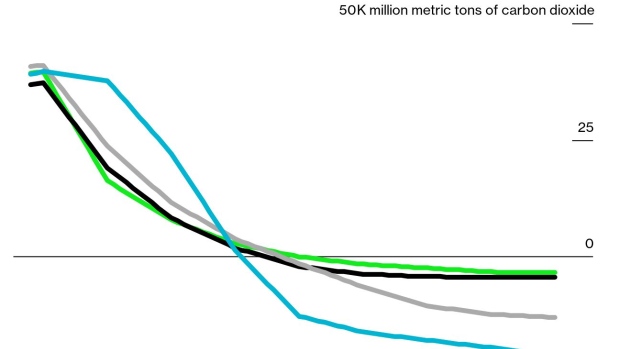Apr 27, 2021
Carbon Restrictions Are Finally Here to Bend the Emissions Curve
, Bloomberg News

(Bloomberg) --
In the science-fiction novel The Ministry for the Future, a devastating heat wave in India kills 20 million people and spurs the creation of a secretive group called the Children of Kali. One of its tactics is to sabotage fossil-fuel powered ships and planes, which forces countries and companies to adopt zero-carbon alternatives to keep the economy ticking.
In reality, the world’s large militarized nations are unlikely to let such a group operate for very long. But the plot illustrates a point that few have fully grasped: If the world takes the goals of the Paris Agreement seriously, simply advancing clean technologies or scaling negative emissions won’t be enough. In the few decades the world has to reach net-zero emissions, we will have to find ways to keep most of our fossil fuel reserves untouched.
Even in fiction, violence isn’t anyone’s preferred way to get there. So how would it work in non-fiction? A few recent developments show that countries are starting to test the waters with prohibitions on burning carbon.
On Friday, California Governor Gavin Newsom announced a ban on new fracking by 2024 and pledged to end all oil extraction by 2045, which is the year the state aims to reach net-zero emissions. Denmark stopped giving new licenses for oil and gas exploration in the North Sea and will end production by 2050. Earlier in April, French lawmakers set in motion a bill that would forbid conventional air travel when the journey can be made by train in two and a half hours or less, with exemptions for “decarbonized” flights. French law aims to reach net-zero emissions by 2050.
These add to larger carbon restrictions announced over the past few years. Most of Europe has agreed to phase out coal power plants. Some European countries and many Californian cities have banned natural-gas connections in new buildings. Many European nations and Canada have set goals to end sales of new fossil-fuel cars before 2050, with Norway aiming for an exit as early as 2025.
In the absence of policymakers explicitly forbidding combustion in certain contexts, there are cascading indirect measures. More than 100 financial institutions, including some development banks, have agreed to divest from coal. Many have also agreed to stop investing in oil sands and drilling in the Arctic. Large international lenders have set goals to cut emissions from their financing activities to net zero by 2050 or sooner. All of which should, in theory, raise the cost of capital for carbon-heavy industries.
In part, these steps are necessary because classic economic measures haven’t worked — or haven’t even been attempted. Some 40 countries have carbon pricing policies, including European Union’s emissions trading scheme, but the impact of these disincentives has often not been enough to shift away from fossil fuels fast enough and make a serious dent in emissions. (There’s also a strong case to be made that a carbon price alone is not good climate policy.)
One of the biggest challenges for any form of carbon restriction is overcoming the negative impact they can have on the local economy. The fossil-fuel industry has now largely come round to supporting a carbon price, but it spent heaps of money in the past opposing those policies. It also engaged in disinformation campaigns that delayed building the consensus among governments that climate change is a problem worth mitigating.
And, yet, governments are only able to exert control over domestic emissions. Carbon restrictions or disincentives on local companies competing in an import-export market can make them less competitive. A steel factory in Europe that has to pay a price of $50 per ton of emissions may not be able to compete with steel coming from China that has had to pay no carbon tax.
That’s why the EU is exploring the use of carbon border tariffs, which would slap higher costs on imports of carbon-heavy goods if they don’t face any penalties at home. It’s one reason why China, a big exporter to Europe, is working to accelerate its deployment of a domestic carbon market. John Kerry, the White House’s special envoy on climate, told Bloomberg News that President Joe Biden is looking at whether the U.S. should consider carbon tariffs too.
If the history of environmental legislation is an indication, any carbon restrictions are likely to contain loopholes. Carbon tariffs, for instance, will rely on precise accounting across countries that have vastly different policies on data transparency. One weapon against such abuse is the use of satellite monitoring that can allow near-real time analysis of greenhouse gas emitters. Tracking of methane has already begun and soon carbon dioxide will also be added to the list.
If the world wants to meet climate goals, the carbon math is brutal. One way or another, society will have to face up to policies that keep a good chunk of fossil fuels in the ground, or pay the price in suffering.
Akshat Rathi writes the Net Zero newsletter on the intersection of climate science and emission-free tech. You can email him with feedback.
©2021 Bloomberg L.P.





